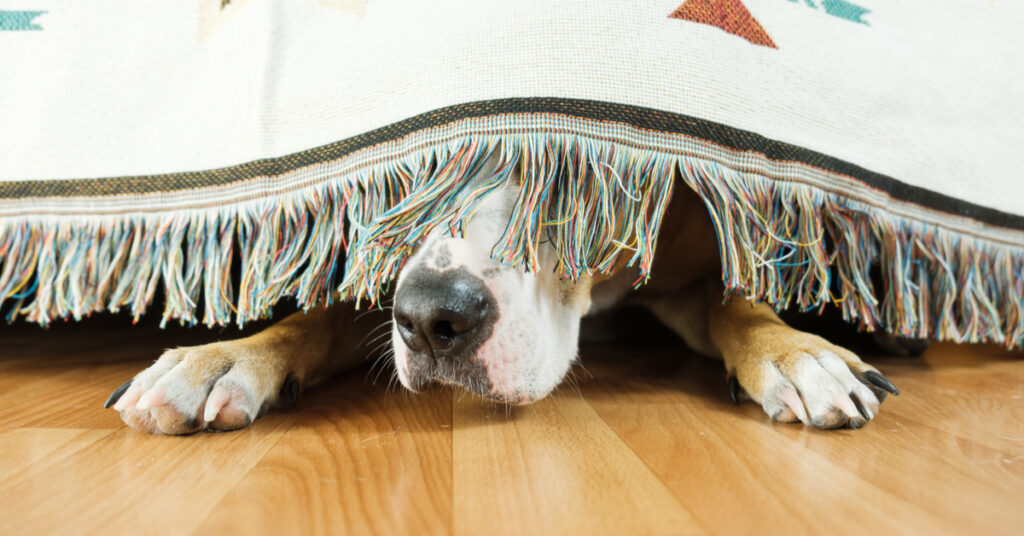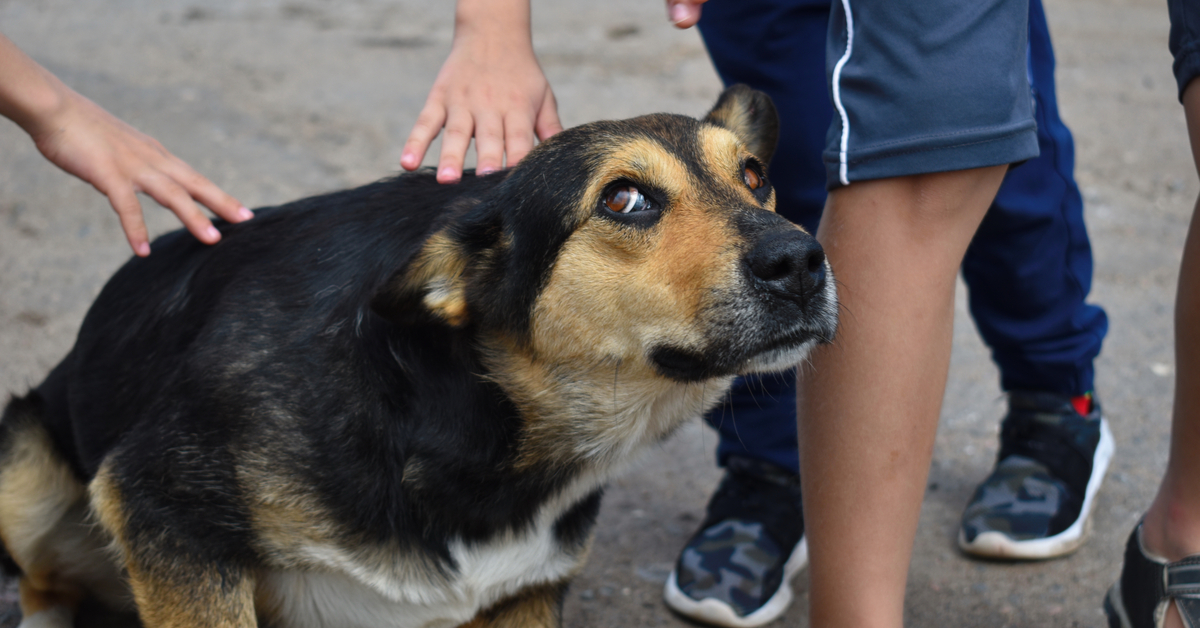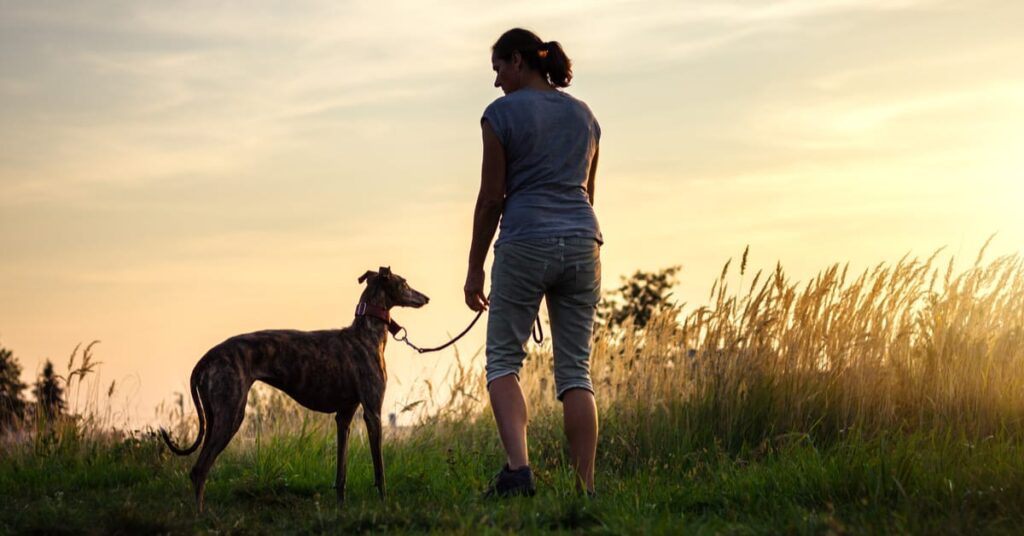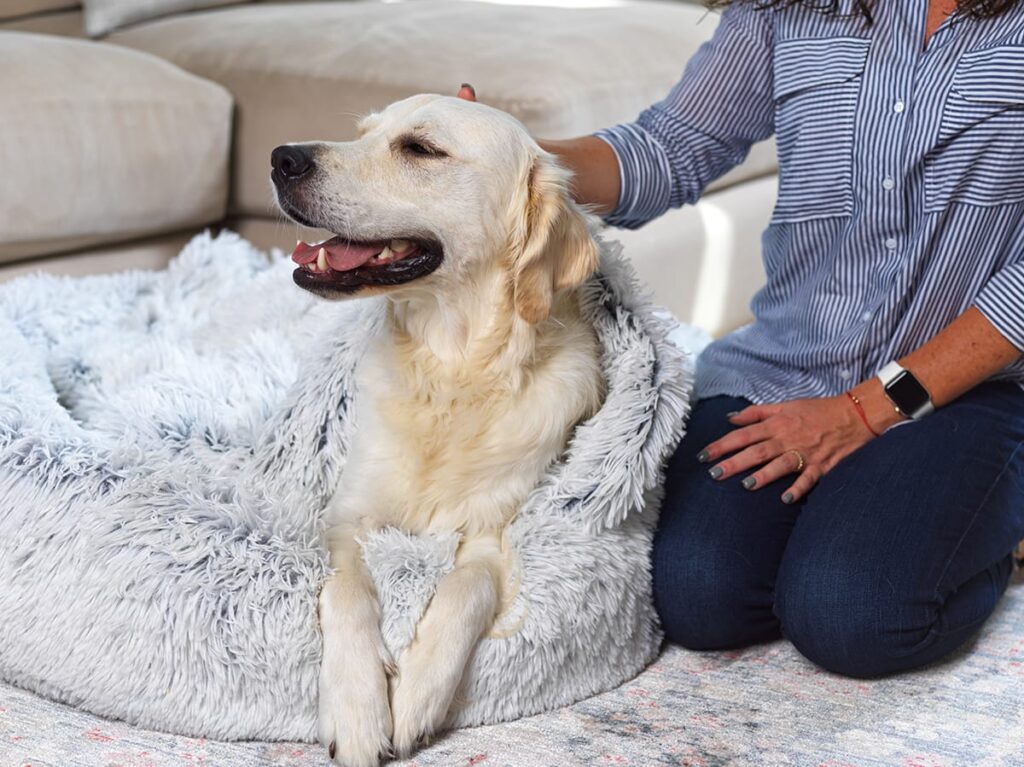Just like people can get triggered, dogs get triggered. Being aware of what is triggering your dog is essential for helping them succeed, develop a training plan that meets your dog’s needs, and doesn’t put them in a position where they are going to be uncomfortable or overstimulated.
When dogs face too many triggers in short succession they can experience “trigger stacking.” With trigger stacking dogs become overwhelmed and unable to regulate their emotions or respond to cues their person gives.
What Are Triggers?

Triggers are anything that elicits a heightened response from your dog. Triggers aren’t always stressful events that upset your dog, they can also be things they find exciting and rewarding.
For example, it might look like a dog who really loves playing fetch may be overstimulated and unable to regulate the build-up of its emotional and behavioral response after a prolonged fetch session or watching other dogs playing fetch.
Ultimately, triggers are any signs, smells, or experiences that raise your dog’s arousal or stress level. Some very emotionally balanced dogs may have few or virtually no obvious triggers. On the other hand, dogs who are anxious can have a wide range of triggers that make them more prone to reactivity and increased stress hormones like cortisol.
Triggers can have sight, hearing, or smell components depending on your dog. For example, for a dog-reactive dog, the sound of jingling tags from your neighbor’s dog, even if they can’t see the dog, can be just as triggering as seeing a dog across the street.
Understanding Arousal Levels
To understand triggers, and trigger stacking it’s important to first understand arousal.
Arousal is a neutral term that references a dog being in a heightened (positive or frustrated) emotional space. A dog who is in an aroused state is a dog who is amped up and ready for action.
For example, a dog who is experiencing a high level of arousal might be hyped up in anticipation for its toy to be thrown. When a dog is in an aroused state, they are fixated on the object of its arousal be that a toy, another dog, a skateboard, load noises from a garbage truck, etc.
High arousal levels make it very difficult for dogs to be redirected or to shift focus. When dogs get triggered their arousal levels increase.
What Is Trigger Stacking?

Similar to going over a dog’s threshold, trigger stacking occurs when multiple triggering situations or experiences occur in quick succession. Specifically, overly excitable or stressful experiences that take dogs out of a headspace where they can respond to cues.
When these triggering (positive or negative) experiences happen close together it doesn’t give dogs the opportunity to recover and regulate their emotions.
This means that instead of calming down after being triggered by a situation, your dog’s arousal builds up with each subsequent trigger. The result is your dog becomes less able to manage its emotions, and less capable of responding to your cues to support emotional regulation.
For the purposes of this article, we will mostly be discussing negative trigger stacking and the impact it can have on training, dog behavior, or something as simple as going for a walk with your dog.
Trigger stacking is upsetting for dogs, and stressful for people. When dogs experience trigger stacking they are overwhelmed and unable to calm down. When your dog feels emotional overload, this translates into behaviors like barking, lunging, or shutting down.
Signs of Trigger Stacking
Signs of stress to watch for to indicate that your dog may be experiencing trigger stacking include:
- heightened awareness of what your dog finds triggering
- inability to focus on you, treats, or toys
- excessive yawning
- lip licking
- panting
- drooling
- snapping
- growling
- turning head away
Pay attention to your dog’s body posture. Dogs who are experiencing trigger stacking may also display common stress signs including a stiff body, lunging, or trying to get away.
How Many Triggers Are Too Many?
In general, in order to set dogs up for success, we must minimize how many negative triggers they encounter. However, the real world doesn’t always resemble our ideal training plans, and triggers can and do appear unexpectedly. How close together triggers need to be to create a stacking situation depends on your individual dog and its temperament.
Many anxious or reactive dogs will have a lower threshold for encountering triggers, meaning it will take fewer triggers for them to shut down or leave them frantically overstimulated. Dogs who in general have a calmer or more stable temperament tend to experience less trigger stacking.
Not only can this differ from dog to dog, but it can also shift day to day depending on health, as well as environmental stressors your dog is experiencing at the time. A dog who can normally handle the sound of a motorcycle down the street may struggle to remain calm if they have just experienced a stressful encounter with another dog, or if they have just left a vet appointment.
The Problem With Trigger Stacking

The big problem with trigger stacking is that it is highly stressful and overwhelming for dogs. When dogs are confined with repeated triggers, especially negative triggers, dogs aren’t learning to be comfortable around them; they are just getting more overwhelmed by them.
Trigger stacking leaves dogs flooded with stress. This makes it difficult or in some cases impossible for them to follow basic cues they know well.
Trigger stacking can occur accidentally, but unfortunately, unethical dog trainers (dog training is an unregulated industry in the United States) can also intentionally flood dogs through trigger stacking.
Flooding is where a dog is purposefully overexposed to its triggers. This practice is often out of the misguided idea that it will help a dog overcome their discomfort/fear. In these instances, dogs who are overwhelmed and shut down can be mistakenly labeled as being calm.
Recovery Time

When a dog has experienced upsetting trigger stacking, the best thing that you can do is to remove your dog from the stressful situation.
When trigger stacking has occurred, dogs aren’t able to effectively learn, focus, or work on counterconditioning to stressful stimuli, making continuing to train in that scenario ineffective. In fact, pushing your dog too hard to continue training during stressful experiences is more likely to lead your dog to shut down, and increase the stress-caused negative behaviors.
After experiencing trigger stacking dogs need time to decompress. This recovery time gives dogs the opportunity to process the experience of having encountered multiple triggers and the chance to emotionally regulate. Some dogs can shake off (often literally, as shaking reduces stress) a trigger stacking situation right away. Other dogs may need a longer period of time. It could take hours or even days to recover.
Ideally, we want to help our dogs to avoid triggers. If they do happen, try to get your dog to a safe and quiet place. Give your dog an opportunity to decompress and rest.
If in a quiet area your dog still seems distressed, try giving them a stuffed enrichment toy or chew. Chewing helps dogs to self-soothe and relax.
Preventing Trigger Stacking

If you know for example that your dog struggles with being around other dogs, you might want to think critically about signing them up for a group training class without discussing the situation with the trainer. Walking into a room with a group of dogs might be more than your dog can emotionally handle.
When dogs experience trigger stacking, they lose the ability to focus and learn in that moment. Try to set your dog up for success. Avoid putting them in situations where you know a lot of potential triggers will be present.
Even if you plan ahead sometimes our dog’s triggers appear where we don’t expect them. To avoid trigger stacking it’s important to be flexible. If you plan a fun outing for your dog but are stressed when you arrive or the location becomes more crowded than you planned, don’t be afraid to change plans and go home early, or to a less populated location.
When dogs get triggered, it’s tempting to push them to work through their discomfort. When dogs experience trigger stacking, they are unable to refocus and calm down until given a chance to decompress. Although it’s best to avoid trigger stacking, dog owners should get their dog to a quiet safe place to recover.

